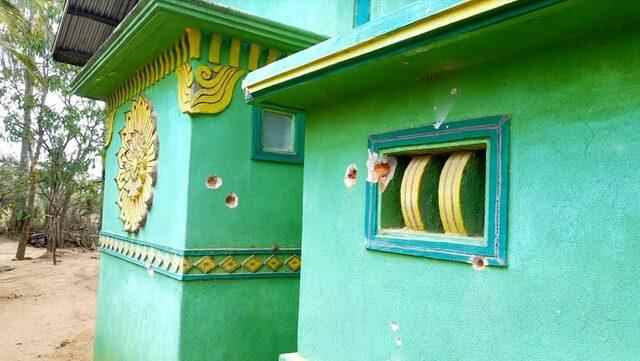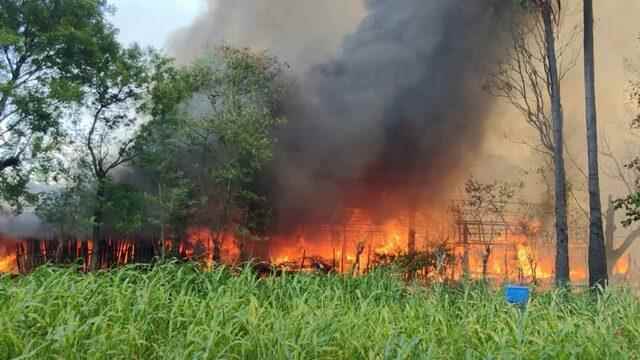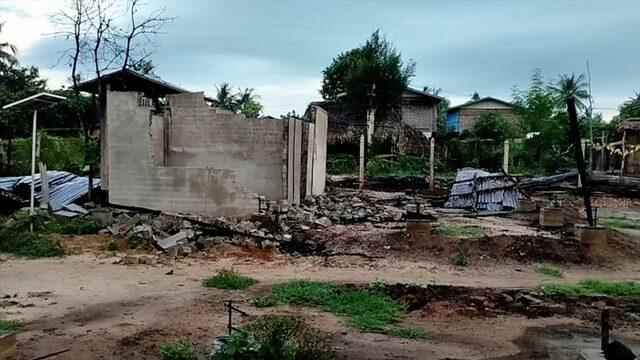The crimes committed by the army, which overthrew the elected government in Myanmar, against civilians came to light one by one. The defected soldiers admitted in a statement that they tortured and killed civilians and raped women.
In private interviews with the BBC, soldiers from the Myanmar army admitted that they killed, tortured and raped civilians. The soldiers described in full detail the widespread human rights violations they said they had committed because they were taking orders.
Warning: This article gives details about sexual violence and torture cases.
“I was ordered to torture, loot and kill innocent people.” Maung Oo says that while he thought he was drafted into the army as a police officer, he was assigned to the battalion that killed civilians hiding in a monastery in May 2022.
“We were ordered to round up and shoot all the men,” he says. “The saddest thing was that we had to kill the elderly and a woman as well.”
The testimonies of six soldiers, including a corporal, and some victims, together offer an inside look at the actions of an army that resorts to every means to maintain its power.
The names of all Myanmarese in this article have been changed in order not to endanger their safety. All of the soldiers whose confessions we have recounted soon left the army and were taken under the protection of the People’s Defense Forces (HSG), a vast network of popular resistance militias fighting for the restoration of democracy.
The army, which overthrew the democratically elected government of Aung San Suu Kyi last year and seized power in Myanmar, is now trying to suppress the popular uprising.
On December 20 of last year, three helicopters hovering over the village of Yae Myet in central Myanmar landed the soldiers who had been ordered to fire.
The BBC listened to five different people, independent of each other, about what happened next.
They describe how the army approached the village in three groups and opened fire indiscriminately on the men, women and children as they entered.
“We were ordered to shoot at everything we saw,” says Corporal Aung, whom we are currently speaking to from an undisclosed remote corner of the Myanmar jungle.
He explains that some were hiding in what they thought was safe, but as the soldiers approached, “we were opening fire as they tried to get out and escape,” he continues.
Corporal Aung admits that his own unit killed and buried five men.
“We were also ordered to burn all the big and neat houses in the village,” he says.
Soldiers are running around the village with torches in hand and shouting “Burn it!”
Corporal Aung explains that he burned four houses. According to the accounts of the people we interviewed, a total of 60 houses were burned that day and most of the village was buried in ashes.
YAE MYET VILLAGE, SAGAING REGION
Swipe left to see lit areas
Most of the villagers had actually fled before, but there were some who lived in a house in the centre.
Thiha joined the army five months before this raid, and she remembers very well what happened in that house.
Like many, he had transitioned from civilian life to military service and was untrained. At that time he had a decent salary of 200 Myanmar Khat ($100) per month. The locals called these newly recruited soldiers Anghar-Sit-Thar, or “mercenaries”.
Through the barred window of the house they were about to burn, Thiha saw a girl locked inside.
“I can’t forget their screams. I still hear them in my ears and carry them in my heart,” he says.
He tells that when he informed his commander that he saw a girl inside, he got the answer, “I told you to kill everyone you see”, and then he set the house on fire.
Corporal Aung of the same unit also hears the screams of the burning girl.
“It was heartbreaking. We heard their screams for about 15 minutes while the house was on fire,” he says.
The BBC tracked down the little girl’s family and spoke to them in front of the ruins of the burned house.
Her relative, U Myint, said that her daughter had mental health problems and that she was alone at home when her parents went to work.
“He tried to escape, but they didn’t let him and they watched it burn,” he says.
This little girl is not the only woman who was the victim of the soldiers’ cruelty in that raid.
Thiha says she joined the army to earn money, but she was shocked by what she was forced to do and the crimes she witnessed.
For example, he describes a group of women detained in Yae Myet village. The officer gave the women to the soldiers and said, “Do whatever you want.” He tells that the soldiers raped the women, but he did not participate.
The BBC managed to find two of these women.
Pa Pa and Khin Htwe describe how they were caught by soldiers on the way while trying to escape. They’re not actually from Yae Myet, but they used to go to a tailor there.
They were kept in the village school for three nights, although they insisted that they were not members of the People’s Defense Forces (HSG) and that they did not even live in this village. They were sexually assaulted by drunken soldiers repeatedly every night.
“They covered my face with a shawl and pushed it to the floor. They took off my clothes and raped me. I was screaming,” Pa Pa recalls.
He begged the soldiers not to do it, but they beat him on the head and threatened him with a gun.
“Then we had to stop resisting because we were afraid they would kill us,” says her sister Khin Htwe. He still trembles as he speaks.
The young women did not dare to look straight into the face of the attackers, but they say that some of them are in military and some in civilian clothes.
Thiha, one of the soldiers who spoke to the BBC, told the BBC: “When they capture young women, they rape them and say, ‘This is what happens to you because you support the People’s Defense Forces.'”
At least 10 people were killed and 8 women reported being raped during the three-day raid on Yae Myet village.
The murderous events in which the mercenary Maung Oo participated occurred on May 2, 2022 in the village of Ohake pho in the Sagaing district.
His account of the incident in which soldiers from the 33rd Light Infantry Division, to which he was a member, rounded up people in a monastery and shot them, is consistent with eyewitness accounts and the horrifying video footage the BBC obtained immediately after the attack.
The video footage shows the bodies of nine civilians, one woman and one white-haired old man, dressed in t-shirts and sarongs, lying side by side on the ground.
Images indicate that these people were shot from behind and at short range.

We also interviewed villagers who witnessed this attack.
In the video, they recognized the young woman lying next to the old man. They say that her name is Ma Moe Moe, she is carrying her child and she has a few pieces of gold in her bag. She begged the soldiers not to take her bag.
Hla Hla, who witnessed the attack and managed to save her life, says, “Even though she had a child in her arms, they took everything and shot them. They also lined up the men and killed them one by one.”
The child in his mother’s arms survived and is now with his relatives.
Hla Hla heard the soldiers bragging on the phone that they had killed eight or nine people. They said that killing people was “delicious”, that this was their “most successful day”.
“Victory! Victory!” He tells them that they broke up with their cries.
Another woman witnessed the murder of her husband. “They shot him in the calf, then told him to lie down and shot him in the hip. They finally shot him in the head,” she says.
She repeats that her husband is not a member of the People’s Defense Forces. “He was a real worker who made a living from palm farming. I have a son and a daughter and I don’t know how to go on living,” he adds.
Maung Oo says he regrets his actions. “That’s why I’ll tell you everything. I want everyone to know that they don’t fall for the same thing,” she says.
Speaking to the BBC, all six soldiers admitted to burning houses and villages in central Myanmar. This indicates that burning villages is a systematic tactic to break popular support for the resistance.
These events coincide with a period when comments were made that the army had difficulty in continuing this multi-front business war.
VILLAGE OF BIN, SAGAING REGION
Swipe left to see lit areas
The group called Myanmar Witness, which tracks human rights violations with information obtained from open sources, reports that it has confirmed more than 200 reports of village burnings in the last 10 months.
The group notes that the number of these burning incidents increased rapidly, while at least 40 attacks were detected in January and February, the minimum number of arson attacks increased to 66 in March and April.
VILLAGES BURNED BY MYANMAR ARMY
Data from September 1, 2021 to June 22, 2022
This is not the first time the Myanmar military has used these tactics. In 2017, there were widespread reports that this method was also used against the Muslim population living in the Arakan state.
Ethnic minorities living in the country’s mountainous regions have also been subjected to this treatment for decades. Some of the armed movements in these regions are now contributing to the armament and training of the People’s Defense Forces.
The approach that goes with impunity for the arbitrary murder and looting of soldiers has prevailed for decades, according to the international human rights watchdog, Human Rights Watch.
It is rare for anyone to be tried or punished for crimes against humanity committed by the army.
However, the Myanmar army is constantly having to recruit new mercenaries due to the increasing number of soldiers killed in HSG attacks and those fleeing from the soldiers.
According to figures given by a group called People’s Hug, a group of former army and police officers, nearly 10,000 soldiers and police have fled and changed sides since the coup in 2021.

Michael Martin of the Center for Strategic and International Studies, a think tank focused on international relations and strategy in the UK, says the Myanmar military is now having a hard time waging war on multiple fronts.
“They have a shortage of personnel at both the officer and private level, they suffer heavy losses, they have difficulty in recruiting new soldiers, they have difficulty in supplying equipment and military equipment. As a reflection of all these, the lands they control in many parts of the country are shrinking.”
The Magway and Sagaing regions, where the above-mentioned events took place, are historically among the regions where the Myanmar army recruited the most soldiers. But young people choose to join the People’s Defense Forces (HSG), not the army.
Corporal Aung, one of the soldiers who spoke to the BBC, is very clear on why he switched sides. “I wouldn’t join the ranks of the people if I believed the military would win in the long run,” he says.
He also explains that the soldiers are now afraid to leave their bases alone and are afraid of being killed by the HSG.
“You can only go to a place with a military unit. In that case, no one can say we are winning,” he says.
We asked for a response by presenting the allegations and testimonies made in this news to the Myanmar army spokesman, General Zaw Zaw Min Tun.
In his written statement, he said that the army did not target civilians, that the two raids described were aimed at legitimate targets and that those killed were “terrorists”.
He denied that the army burned the villages and said that PDF burned the houses.
It is difficult to say how and when this civil war will end, but it looks like it will leave millions of traumatized Myanmarese behind.
And the longer peace is delayed, the more women may be attacked, such as rape survivor Khin Htwe.
Explaining that he still can’t tell his fiancee what happened to him, Khin Htwe says he doesn’t want to live anymore after the attack and is considering suicide.
